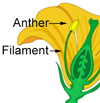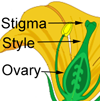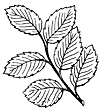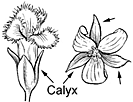Paperbark
Melaleuca quinquenervia
Eucalyptus-Like family (Myrtaceae)
Post-Cook introduction
Paperbark, introduced for ornament and watershed cover, is easily recognized by its odd whitish bark, which splits and peels in many papery layers, by the lance-shaped or narrowly elliptical leaves with mostly five veins from base to and many white flowers with many threadlike crowded and stalkless, suggesting a bottlebrush. Crushed leaves have a resinous odor and taste somewhat like those of eucalyptus.

©2015 Zoya Akulova
Leaves with finely hairy light green leaf-stalks of 1⁄8 inch (3 ). Blades 1 1⁄2–3 1⁄2 inches (4–9 ) long and 1⁄4–3⁄4 inch (6–19 ) wide, long-pointed at both ends, not on edges, slightly thickened and stiff, upper surface gray green and hairless, with five (sometimes seven) veins (as specific name indicates), faint and nearly parallel, lower surface paler and often slightly hairy.
Flower clusters (spikes) 1–3 inches (2.5–7.5 ) long and 1 1⁄2 inches (4 ) across, at end of twig, which elongates and forms new leaves beyond, composed of many crowded stalkless flowers 5⁄8 inch (15 ) long. Flowers have base () 1⁄16 inch (1.5 ) long; of five half-round less than 1.5 long; five concave whitish petals nearly 1⁄8 inch (3 ) long; and about 30 threadlike white nearly 5⁄8 inch (15 ) long, slightly united in five groups at base and failing together early; and composed of inferior 2–4-celled with many ovules, long threadlike white and brown dot
Seed capsules, many crowded and stalkless in groups 1–3 inches (2.5–7.5 ) long on gray twigs back of leaves or between groups of leaves, short cylindrical, 1⁄8 inch (3 ) long and 3⁄16 inch (5 ) wide, gray brown, hard and opening at flattened by 3–4 blunt hairy valves or teeth. Seeds are many, minute, less than 1⁄16 inch (1.5 ) long, very narrow, brown.
Sapwood is pale brown and heartwood light pinkish brown. Wood heavy ( gr. 0.58) with fine texture. Wood grown in Australia is reputed to be resistant to decay and termites, but these properties have not been evaluated for Hawaii-grown wood. Australian wood ( gr. 0.67) is quite strong in bending, tough, and hard, comparable to somewhat denser eucalypts in these properties. Tests of wood from Florida indicate that it is similar in properties to dogwood (Cornus ). The wood has not been used in Hawaii but should be suitable for fence posts. The problem with utilization is that the inside bark diameter of the stems is generally quite small.
A fast growing hardy tree resistant to wind, drought, fires, and salt water and suitable for windbreaks and beach planting. Propagated from seeds.
The thick papery bark has served elsewhere as packing material for caulking for boats, and as torches. Cajeput oil of medicine is obtained from the leaves and twigs of this and related species by steam distillation.
In Hawaii, the paperbark is grown extensively in pure and mixed forest stands for watershed cover, windbreaks, and as an ornamental. Naturalized, but not a pest as in Florida. Forest fires, which cause the seed pods to open and disseminate the seeds, are rare in Hawaii while common in Florida. The first recorded planting by the Division of Forestry was in 1917 on the land of Luaalaea in Manoa Valley, Oahu. Since then, the paperbark has become the third most commonly planted tree in Hawaii, with more than 1.7 million trees planted in the Forest Reserves, because it thrives on very harsh eroded and wet sites where others do not.
Special areas
Tantalus, Kalopa
Champion
Height 75 ft (22.9 ), c.b.h. 10.2 ft (3.1 ), spread 66 ft (20.1 ). State Forestry Arboretum, Hilo, Hawaii (1968).
Range
Native from eastern Australia to New Caledonia and Papua, where it grows on coastal flats. Planted and naturalized in tropical regions. Naturalized and very common in southern Florida. Planted also in southern Texas, southern California, and Puerto Rico.
Other common names
paperbark-tree, bottlebrush, punk-tree; cayeputi, cayeput (Puerto Rico)
Formerly referred to as Melaleuca leucadendron (L) L, a related species of northern and northeastern Australia, southern New Guinea, and Amboina.





